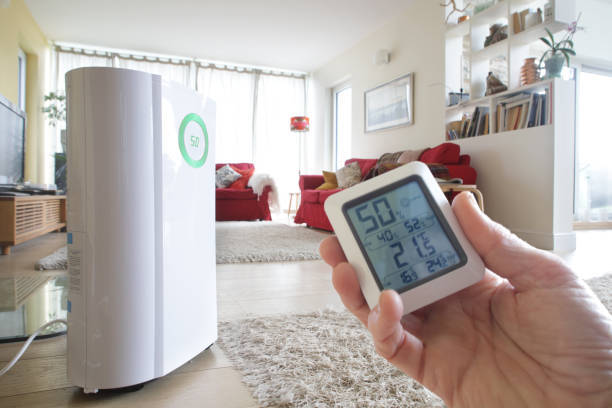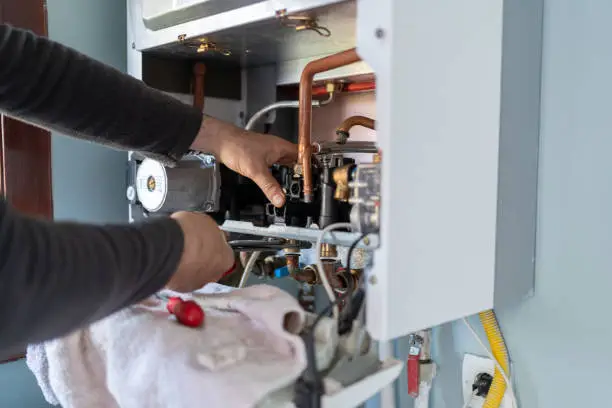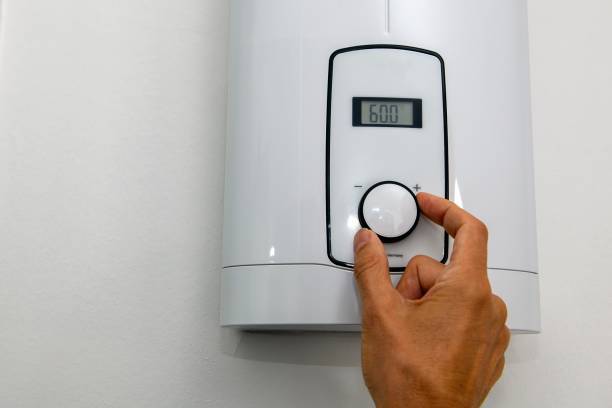
Table of Contents
Hey there! Ever wonder why your home might feel stuffy, or why allergies flare up indoors? The culprit might be your indoor air quality (IAQ). It’s not just about comfort; IAQ is crucial for your health and well-being. Poor air quality can lead to headaches, fatigue, respiratory issues, and even serious health problems over time. Pollutants like dust, volatile organic compounds (VOCs), mold, and CO2 can sneak into your home from various sources like cleaning products, building materials, and even your pets. Keeping an eye on these is essential.
Role of Indoor Air Quality Monitors
That’s where indoor air quality monitors come into play. These nifty devices help you keep track of what’s floating around in your air. They alert you to rising pollutant levels, help you take action before problems arise, and ultimately, improve your living environment. Whether you’re a parent wanting a safe space for your kids, or just someone who values fresh air, IAQ monitors are a game changer.
Top Indoor Air Quality Monitors of 2024
Choosing the right air quality monitor can make a world of difference in ensuring your home is a safe and healthy place to live. Let’s take a closer look at some of the best indoor air quality monitors of 2024, so you can find the perfect match for your needs.
Airthings Wave Plus
- Manufacturer: Airthings
- Key Features:
- Monitors radon, CO2, VOCs, humidity, temperature, and air pressure
- Smart integration with Google Assistant, Amazon Alexa, and IFTTT
- Bluetooth connectivity with the Airthings app
- Visual indicators with color-coded LED ring
- Specifications:
- Dimensions: 4.7 x 4.7 x 1.4 inches
- Battery life: Up to 16 months
- Operating temperature: 39°F to 104°F (4°C to 40°C)
- Weight: 7.8 ounces
- Pros:
- Comprehensive range of detected pollutants
- User-friendly app with detailed insights and historical data
- Easy to set up and use
- Long battery life
- Cons:
- No real-time alerts without the app
- Limited connectivity options (Bluetooth only)
- Price Range: $230 – $260
The Airthings Wave Plus is a fantastic all-around monitor, especially if you want a broad view of your indoor air quality. It’s great for homes where radon might be a concern, and the long battery life means you won’t be constantly changing batteries.
IQAir AirVisual Pro
- Manufacturer: IQAir
- Key Features:
- Measures PM2.5, CO2, temperature, and humidity
- Large, high-resolution display for real-time data
- Wi-Fi connectivity for remote monitoring via the AirVisual app
- Integrated weather and air quality forecasting
- Specifications:
- Dimensions: 7.2 x 4.3 x 3.1 inches
- Battery life: 6 hours on a full charge
- Operating temperature: 23°F to 113°F (-5°C to 45°C)
- Weight: 1.3 pounds
- Pros:
- Highly accurate PM2.5 and CO2 measurements
- Comprehensive and visually appealing display
- Remote access and monitoring capabilities
- Built-in battery for portability
- Cons:
- Higher price point
- Battery life could be longer
- Price Range: $270 – $300
The IQAir AirVisual Pro is perfect if you love detailed data and remote monitoring. Its large display gives you a snapshot of your air quality at a glance, and the ability to check in from anywhere via the app is super convenient.
Foobot
- Manufacturer: Airboxlab
- Key Features:
- Monitors VOCs, PM2.5, CO2, temperature, and humidity
- Wi-Fi connectivity with a dedicated app
- Integration with smart home systems like Amazon Alexa and IFTTT
- LED indicator for quick air quality status
- Specifications:
- Dimensions: 6.8 x 3.2 x 3.2 inches
- Power: USB powered
- Operating temperature: 32°F to 104°F (0°C to 40°C)
- Weight: 1.4 pounds
- Pros:
- Easy-to-read LED indicator
- Integration with various smart home systems
- Detailed historical data and trends in the app
- Affordable price point
- Cons:
- No battery backup, requires constant power
- Limited range of pollutants detected compared to competitors
- Price Range: $180 – $200
Foobot is a solid choice if you’re looking for a budget-friendly option that still offers smart home integration. Its LED indicator is a quick way to check your air quality without pulling out your phone.
Awair Element
- Manufacturer: Awair
- Key Features:
- Tracks PM2.5, VOCs, CO2, temperature, and humidity
- Wi-Fi connectivity for real-time monitoring
- Integration with Google Assistant, Amazon Alexa, and other smart home devices
- Personalized recommendations for improving air quality
- Specifications:
- Dimensions: 6.3 x 1.8 x 3.4 inches
- Power: USB powered
- Operating temperature: 41°F to 104°F (5°C to 40°C)
- Weight: 0.9 pounds
- Pros:
- Sleek and modern design
- Provides actionable insights and tips
- Easy to set up and use
- Good range of detected pollutants
- Cons:
- Requires Wi-Fi for full functionality
- No display on the device itself
- Price Range: $150 – $170
The Awair Element is great if you appreciate a device that not only monitors air quality but also provides tips to improve it. Its modern design fits well in any home, and it’s easy to set up and get started.
uHoo
- Manufacturer: uHoo
- Key Features:
- Measures 9 air quality parameters: PM2.5, CO2, VOCs, temperature, humidity, air pressure, ozone, nitrogen dioxide, and carbon monoxide
- Wi-Fi connectivity with comprehensive app integration
- Real-time alerts and historical data tracking
- Compatibility with various smart home systems
- Specifications:
- Dimensions: 3.4 x 3.4 x 6.8 inches
- Power: USB powered
- Operating temperature: 32°F to 104°F (0°C to 40°C)
- Weight: 1.1 pounds
- Pros:
- Extensive range of detected pollutants
- Real-time notifications and alerts
- Highly detailed app with extensive data insights
- Smart home integration capabilities
- Cons:
- Higher price point
- Requires constant power supply
- Price Range: $320 – $350
uHoo is the most comprehensive monitor on our list, perfect for those who want to track almost everything affecting indoor air quality. Its extensive range of sensors and smart home integration make it a powerful tool for any home.
Best Indoor Air Quality Monitors: What to Look For

1. Accuracy
When it comes to indoor air quality monitors, accuracy is paramount. We tested each monitor’s ability to detect pollutants like PM2.5, VOCs, CO2, and more. Accuracy was rated based on how closely their readings matched professional-grade equipment. Monitors like the IQAir AirVisual Pro and uHoo stood out with their precise measurements.
2. Features
We looked at various features, from basic pollutant detection to smart home integration and real-time alerts. Features like Wi-Fi connectivity, mobile apps, and visual indicators were also considered. Monitors like the Airthings Wave Plus and Awair Element offer a balance of essential features and smart home compatibility.
3. Ease of Use
An IAQ monitor should be easy to set up and operate. We evaluated user interfaces, app functionality, and overall user experience. The Foobot and Awair Element excelled here with their intuitive designs and straightforward apps.
4. Design and Build Quality
We looked at various features, from basic pollutant detection to smart home integration and real-time alerts. Features like Wi-Fi connectivity, mobile apps, and visual indicators were also considered. Monitors like the Airthings Wave Plus and Awair Element offer a balance of essential features and smart home compatibility.
5. Value for Money
Value for money was determined by comparing the features and performance of each monitor against its price. Budget-friendly options like the Foobot offer great value, while higher-end models like the uHoo provide extensive features that justify their price tags.
For the professional indoor air quality service in Canada reach out to HVAC Service Solutions via the link below.
How to Choose the Best Air Quality Monitor

Choosing the right indoor air quality monitor involves considering several factors to ensure it meets your specific needs. Here’s a detailed guide to help you make an informed decision.
Factors to Consider When Choosing an IAQ Monitor
1. Pollutants Detected
Different monitors detect different pollutants. Determine which pollutants are most relevant to your environment. For instance, if radon is a concern in your area, look for monitors like the Airthings Wave Plus that specifically detect radon. Other common pollutants include CO2, VOCs, and PM2.5.
2. Connectivity Options
Consider whether you need Wi-Fi, Bluetooth, or smart home integration. Wi-Fi connectivity allows for remote monitoring and real-time alerts, while Bluetooth can be simpler to set up. Smart home integration adds convenience if you use systems like Google Assistant, Amazon Alexa, or IFTTT.
3. Power Source
Decide between battery-powered or USB-powered options based on your preference for portability or constant monitoring. Battery-powered monitors are more portable but may require frequent battery changes. USB-powered monitors offer continuous monitoring without the hassle of changing batteries.
4. Additional Features
Look for extra features like historical data tracking, real-time alerts, and air quality forecasting. These features can provide deeper insights into your air quality trends and help you take proactive measures.
Types of Indoor Air Quality Monitors
Standalone Units: Ideal for single-room monitoring, standalone units are typically more affordable and easy to use. Examples include the Foobot and Awair Element.
Standalone units are great for targeted monitoring and are usually simpler to set up.
Smart Monitors: These integrate with smart home systems and offer advanced features. The Airthings Wave Plus and uHoo are excellent choices for users looking for seamless smart home integration and enhanced functionality.
Smart monitors offer greater convenience and advanced monitoring capabilities.
Professional-Grade Devices: Best for comprehensive monitoring and precise data, professional-grade devices like the IQAir AirVisual Pro provide high accuracy and detailed air quality insights.
Professional-grade devices are ideal for users needing detailed, precise air quality data.
Conclusion
In conclusion, choosing the right indoor air quality monitor plays a crucial role in ensuring a healthy and safe atmosphere for your home or office. Monitoring levels of harmful substances in the air helps identify issues early and take measures to address them, which is especially important for protecting the health of your family or staff. Our recommendations include the best models of 2024, ranging from straightforward and affordable options to advanced devices with smart home integration. Contact HVAC Service Solutions for professional consultation and assistance in selecting and installing the perfect monitor for your needs. Ensure clean indoor air in your home today!
Frequent Asked Questions
What is an indoor air quality (IAQ) monitor?
An indoor air quality (IAQ) monitor is a device designed to measure and monitor various pollutants and conditions present in indoor air. These devices can detect a wide range of contaminants such as volatile organic compounds (VOCs), carbon dioxide (CO2), particulate matter (PM), humidity levels, temperature, radon, carbon monoxide (CO), and more. IAQ monitors provide real-time or periodic measurements to help users understand the quality of the air they breathe indoors and take appropriate actions to maintain healthier indoor environments.
Why should I monitor indoor air quality?
Monitoring indoor air quality is crucial for several reasons. Poor indoor air quality can lead to a variety of health issues such as respiratory problems, allergies, and headaches. By continuously monitoring IAQ, you can identify sources of pollutants, track trends in air quality over time, and implement effective strategies to improve indoor air quality. This proactive approach helps create a healthier and more comfortable living or working environment for occupants.
What pollutants do indoor air quality monitors detect?
Indoor air quality monitors can detect a wide range of pollutants depending on their sensors and capabilities. Common pollutants include VOCs (from cleaning products, paints, and furnishings), CO2 (from human respiration and combustion), PM2.5 and PM10 particles (from dust, smoke, and pollutants), radon (a radioactive gas from soil and building materials), ozone (from air purifiers and outdoor sources), nitrogen dioxide (from combustion processes), carbon monoxide (from incomplete combustion), and more. Each pollutant can impact indoor air quality differently, and monitoring multiple pollutants provides a comprehensive assessment of IAQ.
How do indoor air quality monitors work?
IAQ monitors typically work by using sensors specific to each pollutant they detect. For example, VOC sensors may use photoionization detectors (PIDs), CO2 sensors use infrared sensors to measure gas concentration, and PM sensors use optical methods to count and measure particle sizes. The sensors collect data which is then processed and displayed on the monitor or transmitted wirelessly to a connected device. Some monitors may also offer additional features like data logging, alerts, and integration with smart home systems for enhanced usability.
What are the benefits of using a smart IAQ monitor?
Smart IAQ monitors offer several advantages over traditional monitors. They can connect to Wi-Fi networks, allowing users to access real-time data and receive alerts remotely via smartphone apps or web interfaces. Integration with smart home systems such as Google Assistant or Amazon Alexa enables voice commands and automated actions based on air quality readings. Smart monitors often provide more detailed insights into IAQ trends, historical data analysis, and personalized recommendations for improving air quality, making them a convenient and effective tool for maintaining healthier indoor environments.
Where should I place an indoor air quality monitor?
Proper placement of an indoor air quality monitor is essential for accurate readings. Ideally, place monitors in rooms where occupants spend the most time, such as living rooms, bedrooms, or home offices. Avoid placing them near sources of heat or humidity, direct sunlight, or in areas with obstructed airflow. Placing monitors at breathing height (around chest level) and away from walls or corners provides more representative readings of overall indoor air quality in the space.
How often should I calibrate my indoor air quality monitor?
Calibration frequency for IAQ monitors depends on the manufacturer’s recommendations and the type of sensors used. Some monitors may require annual calibration by trained professionals to maintain accuracy, especially for sensors detecting gases like CO2 or VOCs. Regular calibration ensures that the monitor continues to provide reliable measurements and adheres to industry standards for accuracy in IAQ monitoring.
Do indoor air quality monitors require maintenance?
Yes, indoor air quality monitors typically require regular maintenance to ensure accurate and reliable performance. Maintenance tasks may include cleaning the sensors to remove dust and debris that can affect readings, replacing filters if applicable, and checking the power source (e.g., batteries or power supply) to ensure continuous operation. Follow the manufacturer’s guidelines for maintenance intervals and procedures to maximize the lifespan and effectiveness of your IAQ monitor. Proper maintenance contributes to consistent monitoring results and supports healthier indoor environments for occupants.
Can indoor air quality monitors detect mold or allergens?
IAQ monitors primarily detect airborne pollutants such as VOCs, CO2, PM particles, and gases like radon and carbon monoxide. While they do not directly measure specific allergens like pollen or mold spores, these monitors can indirectly indicate poor air quality associated with allergens. Elevated levels of certain pollutants may suggest conditions conducive to mold growth or increased allergen concentrations indoors. Monitoring IAQ can help identify potential sources of allergens and support efforts to improve indoor air quality for allergy-sensitive individuals.
How can I interpret the data from an indoor air quality monitor?
If your air conditioner is not cooling effectively, several troubleshooting steps can help identify and resolve the issue:
- Check Thermostat Settings: Ensure the thermostat is set to cooling mode and at the desired temperature.
- Inspect Air Filters: Dirty or clogged filters can restrict airflow and reduce cooling efficiency. Clean or replace filters as needed.
- Examine Air Vents: Ensure air vents are open and unobstructed to allow proper airflow throughout your home or business.
- Inspect Outdoor Unit: Clear debris such as leaves or grass clippings from around the outdoor unit to maintain proper airflow and heat transfer.
- Check for Refrigerant Leaks: Low refrigerant levels can indicate a leak or other issues requiring professional attention.
- Schedule Maintenance: If issues persist, schedule a professional inspection and maintenance service to diagnose and repair any underlying problems.
Prompt action and regular maintenance help ensure your air conditioner operates efficiently, providing reliable cooling when you need it most.
Share


















